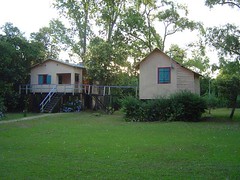On New Year’s Day we went with our friends Ceci and Nestor to Tigre, the fascinating Paraná river delta that flows into the Rio de la Plata. Tigre itself is a small town but the name also refers to the vast waterways throughout the delta where many residents of Buenos Aires have second homes.
Scattered across hundreds of small islands, the only way to access the interior is by boat. Most of the residents have a boat that they keep in dry storage when not visiting the islands. During the thirty or so minute boat ride we passed a number of homes that range in size and quality. Some are very nice, practically luxurious, others are simple and pleasant and then there are those like Nestor’s: primitive and without electricity. But, somehow, it fits a fifty-something photographer who drives a classic Citroen. (The house in the photo is not Nestor’s but the nicer one next door). Of course, electricity isn’t needed for a great asado and it was an interesting experience.
While relaxing in a hammock next to the stream that runs in front of the house I had the chance to finish reading a story by Bioy Casares, “De la forma del mundo”. The story is set in Tigre and, ostensibly, is about a secret tunnel on one of the islands in the delta that provides a five-minute shortcut to Punta del Este, which is a resort almost 400km away on the far coast of Uruguay. Incidentally, Punta del Este is where many of the pretentious set from Buenos Aires are currently basking in the sun. (Having lived in South Beach I’ve had enough of that).
Back to Bioy’s story: the young narrator named Correa is shown the tunnel by a mysterious dentist that he met on the ferry to Tigre. The story is set in 1951 and there’s a subplot of smuggling goods from Uruguay to Argentina. I learned through the story that Perón had banned travel to Uruguay, something which I didn’t know before. The story revolves around the possible untruths between the narrator and the dentist, and then among others later in the story.
Correa meets Cecilia, a woman in Punta del Este who is very sad over a husband who had deceived her and left her for a younger woman. Cecilia begins to fall in love with Correa, who tells her about the tunnel. Correa doesn’t understand Cecilia’s lack of fascination over the tunnel or why she then says to him, “Por más que te acompañe, un mentiroso te deja sola.” [ “No matter how good a companion he is, you’re always alone with a liar.”, tr. SL Levine].
The nickname of the narrator is “el Geógrafo” [the Geographer]. Allusions to mapmaking and how once firm notions turn out to be false, such as the world is flat, are never far from the surface of Bioy’s story. Building to a suspenseful ending, “De la forma del mundo” ultimately becomes an examination of lies, beliefs about the truth, and the validity of knowledge that is passed from one person to another.
